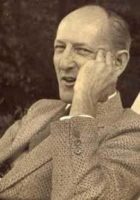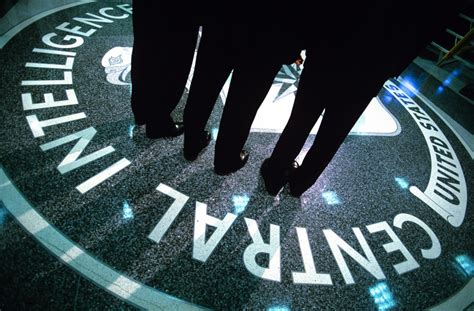by Charles Lear
 Of all the private organizations devoted to UFO investigation, the National Investigations Committee on Aerial Phenomena was arguably the most ambitious and tenacious. This was driven in large part by its director, Donald Keyhoe. Keyhoe held the beliefs that UFOs are extraterrestrial and that the U.S. Government, particularly the Air Force, was keeping information from the public that could possibly prove the ET hypothesis. As effective as NICAP was at hounding the Air Force and convincing many in the U.S. Congress that UFOs were deserving of scientific study, there are indications that the CIA was involved in both the beginning and the end of the organization.
Of all the private organizations devoted to UFO investigation, the National Investigations Committee on Aerial Phenomena was arguably the most ambitious and tenacious. This was driven in large part by its director, Donald Keyhoe. Keyhoe held the beliefs that UFOs are extraterrestrial and that the U.S. Government, particularly the Air Force, was keeping information from the public that could possibly prove the ET hypothesis. As effective as NICAP was at hounding the Air Force and convincing many in the U.S. Congress that UFOs were deserving of scientific study, there are indications that the CIA was involved in both the beginning and the end of the organization.
 Todd Zechel wrote about the CIA – NICAP connection in the January 1979 issue of Just Cause, the newsletter put out by Citizens Against UFO Secrecy. NICAP was incorporated in 1956, and two men Zechel argues were covert CIA operatives were put into chair positions within the organization. One of these men was Bernard J. O. Carvalho, who was made the chairman of NICAP’s membership subcommittee According to Zechel, Carvalho worked as a “front man” for companies secretly run by the CIA. The other was “Count” Nicolas de Rochefort, who was made Vice-Chairman of NICAP. According to Zechel, de Rochefort worked with the CIA’s Psychological Warfare Staff. Zechel tells the reader “there is more than ample evidence to conclusively establish both de Rochefort and Cavalho were at least during certain periods of their lives covert employees of the Central Intelligence Agency.”
Todd Zechel wrote about the CIA – NICAP connection in the January 1979 issue of Just Cause, the newsletter put out by Citizens Against UFO Secrecy. NICAP was incorporated in 1956, and two men Zechel argues were covert CIA operatives were put into chair positions within the organization. One of these men was Bernard J. O. Carvalho, who was made the chairman of NICAP’s membership subcommittee According to Zechel, Carvalho worked as a “front man” for companies secretly run by the CIA. The other was “Count” Nicolas de Rochefort, who was made Vice-Chairman of NICAP. According to Zechel, de Rochefort worked with the CIA’s Psychological Warfare Staff. Zechel tells the reader “there is more than ample evidence to conclusively establish both de Rochefort and Cavalho were at least during certain periods of their lives covert employees of the Central Intelligence Agency.”
The first director of NICAP was one of its founders, T. Townsend Brown. Zechel tells the reader that the Air Force had an interest in Brown’s “propulsion theories” since the early ‘50s (he claimed to have developed an anti-gravity device) and proposes that the CIA would have taken an interest in Brown for this reason. He also argues that because of the CIA’s concern about possible subversive activity by UFO groups, as mentioned in the 1953 Robertson Panel Report, “one might well expect to find covert CIA agents infiltrating a newly-founded, Washington-based UFO organization.”
 Brown was removed as director at the end of 1956 and both Carvalho and de Rochefort left shortly thereafter. Brown was replaced by Major Donald E. Keyhoe (USMC – Ret.). Keyhoe had been a classmate of Vice-Admiral Roscoe Hillenkoetter (USN – Ret.) at the Naval Academy in Annapolis, Maryland, and he got Hillenkoetter to agree to sit on NICAP’s board of governors. Hillenkoetter was the first director of the CIA, so this is a definite connection between the CIA and NICAP.
Brown was removed as director at the end of 1956 and both Carvalho and de Rochefort left shortly thereafter. Brown was replaced by Major Donald E. Keyhoe (USMC – Ret.). Keyhoe had been a classmate of Vice-Admiral Roscoe Hillenkoetter (USN – Ret.) at the Naval Academy in Annapolis, Maryland, and he got Hillenkoetter to agree to sit on NICAP’s board of governors. Hillenkoetter was the first director of the CIA, so this is a definite connection between the CIA and NICAP.
It doesn’t seem as if Hillenkoetter was under any direct influence by the CIA while he was with NICAP. Hillenkoetter’s publicly stated beliefs aligned with those of Keyhoe and NICAP, and he openly accused the Air Force of misleading the American public when it came to UFOs and urged action by Congress to “reduce the danger from secrecy.”
Zechel asserts that in 1962, Keyhoe was far along in his efforts to force Congress into holding open hearings on UFOs and the Air Force’s handling of the subject. He says that much of Keyhoe’s evidence (that UFOs were real and under extraterrestrial control) was based on information from confidential sources Keyhoe couldn’t be sure would testify and that Keyhoe was counting on Hillenkoetter “to make condemnations of the Air Force and carry the day.”
Hillenkoetter then resigned from the board and in his letter of resignation wrote “The Air Force cannot do more under the circumstances . . . and I believe we should not continue to criticize their investigations . . .” Zechel references the 1977 Ground Saucer Watch FOIA lawsuit that resulted in the release of UFO related CIA files in 1978 and “without going into details at the present time” assures the reader that Hillenkoetter was pressured by the CIA after the Agency received complaints from Air Force officials about Hillenkoetter’s role in NICAP.
 Under Keyhoe’s direction, NICAP kept up the pressure on Congress and the Air Force. In 1966, NICAP was instrumental in moving Congress to hold a hearing on UFOs by the Committee on Armed Services, where representatives of the Air Force and its UFO investigation, Project Blue Book, were asked about their handling of the UFO problem. If the CIA had indeed infiltrated NICAP, it certainly didn’t defang the organization.
Under Keyhoe’s direction, NICAP kept up the pressure on Congress and the Air Force. In 1966, NICAP was instrumental in moving Congress to hold a hearing on UFOs by the Committee on Armed Services, where representatives of the Air Force and its UFO investigation, Project Blue Book, were asked about their handling of the UFO problem. If the CIA had indeed infiltrated NICAP, it certainly didn’t defang the organization.
Zechel then addresses the presence on the board at the time of his writing of Col. Joseph Bryan III (USAF – Ret.), whom he describes as the founder and original Chief of the CIA’s Psychological Warfare Staff (1947-53). Zechel says that during interviews he held with Bryan, Bryan confirmed his CIA connections. Bryan asked that his position as a covert CIA operative not be made public and denied having any connection or communication with the Agency while he sat on NICAP’S board. When it was suggested to Bryan that two CIA covert agents had “penetrated NICAP at its very beginning, Bryan replied “There’s nothing to penetrate about – it was all overt, the whole thing.”
Keyhoe was removed as director of NICAP in 1969 due to his poor handling of NICAP finances. According to Zechel, Bryan denied having anything to with it during an interview Zechel held with him in 1977. Then, Zechel points out that NICAP files on the meeting establish that Bryan was chairman of the board at the time and distributed a memo where he labeled Keyhoe as inept.
After Keyhoe was removed as director (he was “kicked upstairs” and moved to the board) Jack Acuff took over. Acuff had been the head of the Society of Photographic Scientists and Engineers which, according to Zechel, “had been the target of frequent KGB spying attempts” due to the fact that many of its members were CIA photo analysts. Zechel says that Acuff had been approached by Soviet agents “on several occasions” and reported this to the FBI. He began meeting with the Soviets at the behest of the FBI “acting, in effect, as a covert agent.”
Another suspected CIA affiliate in the NICAP organization was G. Stuart Nixon who, in 1973, was an assistant to Acuff. Zechel references a document from the CIA where “an unnamed person . . . indicates some familiarity with G. Stuart Nixon. Zechel also points out that daily NICAP logs “reflect that Nixon met with several past and present (then) CIA employees on a frequent basis.”
At the time of Zechel’s writing, NICAP was withering and close to death as an organization and Acuff had been replaced by Alan C. Hall, “a retired CIA employee living in Bethesda.” Zechel concludes his article by bringing up the theory that the CIA had purposely destroyed “the leading anti-secrecy organization of the 1960s” and stops short of agreeing with this.
This possibility was debated online by NICAP insiders, including Fran Ridge Gordon Lore, and Jan Aldrich, as recently as 2018, and they were unable to agree on whether it was the CIA or just poor management that killed NICAP. The CIA – NICAP connection was looked into deeply by Jack Brewer in his 2021 book, “Wayward Sons: NICAP and the IC. Brewer did extensive research and filed FOIA requests and was unable to positively identify any of the suspected CIA covert agents as such, though the evidence he presents appears convincing. Brewer leans towards the idea that the CIA helped set up the organization and used it as an asset for various purposes, including propaganda, leak detection, money laundering, and then put an end to it when it outlived its usefulness. He, like Zechel, stops short of reaching a final conclusion, so the question of whether or not the CIA had a hand in NICAP’s beginning and end remains an open one.